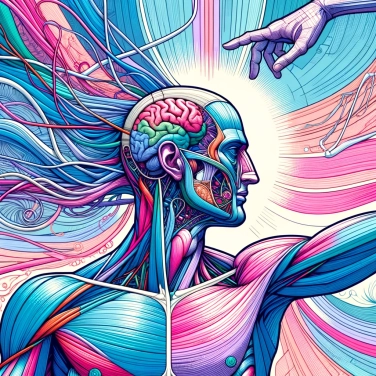Leonardo da Vinci studied human anatomy extensively to better understand the functioning of the human body and improve the accuracy of his artistic works, particularly his paintings and sculptures.

Leonardo da Vinci had a very curious mind; he was interested in everything related to living beings, and he was particularly fascinated by the human body. He wanted to know how everything worked inside: muscles, bones, organs, blood vessels—nothing escaped his gaze. Through numerous dissections, he observed the smallest anatomical details, asked questions, and meticulously took notes. His goal was simple: to understand how the parts of the body are interconnected, why they move in that way, and what biological mechanism lies behind each of our gestures. This insatiable curiosity allowed him to deepen his perception of humanity well beyond appearances.
Leonard was determined that his works had a stunning realism. To make this possible, he started studying muscles, bones, and all those little details hidden beneath the skin. Because he knew that to credibly depict movement or emotion, one had to fully understand how the human body works. Thus, by examining bodies and cadavers, and drawing ultra-precise sketches, he could perfectly reproduce reality. He was so keen to perfect his paintings that he personally dissected bodies to grasp exactly how every muscle or tendon functions — clearly an extreme but highly effective approach. Thanks to these in-depth studies, his paintings like the Mona Lisa or the Vitruvian Man became unbeatable references in terms of anatomical realism.
Leonardo da Vinci used human anatomy to innovate technically and scientifically. He dissected numerous human bodies, directly studying the musculature, joints, the functioning of internal organs, and the circulatory system. His discoveries led him to create very precise sketches representing astonishing inventions, such as mechanisms inspired by the natural movements of the body. These diagrams helped to better understand the principles of biomechanics, that is, how anatomical structures work together to produce movement. Through this pioneering approach, he contributed significantly to the scientific understanding of the human body and opened new pathways for practical applications of machines or tools inspired by living organisms.
Leonardo da Vinci dissected human corpses (over thirty known) to observe the internal mechanics of the body closely, creating anatomical drawings that were quite accurate for his time. Thanks to his detailed plates, he enabled major advances in the understanding of the human body by clearly depicting organs such as the heart and the brain, as well as muscles, bones, and tendons. His notes were filled with incredibly precise diagrams that helped unravel some common medical errors of his time, for example regarding cardiac function or muscular movements. Although few could truly benefit directly from his work during his time (he did not publish it widely), his notebooks greatly influenced future generations of doctors and scientists, paving the way for a more accurate and modern understanding of anatomy.
Did you know that Leonardo da Vinci's anatomical drawings were so precise that they could have revolutionized medicine in his time, if only they had been published during his lifetime?
Did you know that beyond human anatomy, Leonardo also studied animal anatomy, particularly observing the flight of birds to design his flying machines?
Did you know that Leonardo was one of the very first to clearly represent the functioning of the human heart, illustrating the heart valves with great accuracy?
Did you know that Leonardo's interest in anatomy was also driven by his artistic quest, allowing him to enhance realism and emotional expressions in his paintings, such as the Mona Lisa?
In-depth studies of anatomy allowed Leonardo to significantly enhance the realism of his works, particularly through the faithful representation of muscles, body proportions, and facial expressions.
These anatomical drawings were not intended for immediate publication, and Leonardo himself was hesitant to share them widely. Many of his manuscripts remained private or unfinished, thereby limiting their distribution during his lifetime.
Although his works were not revealed immediately, when they were discovered, his precise anatomical drawings made significant contributions to the subsequent evolution of anatomy and medical sciences through their remarkable accuracy and methodological approach.
Yes, some anatomical manuscripts and drawings by Leonardo still contain coded, incomplete, or complex annotations that continue to challenge current specialists in the complete interpretation of his works.
Leonardo primarily used human and animal dissections, meticulous observation, and detailed illustrations to study anatomy, thus combining his artistic and scientific talents.

0% of respondents passed this quiz completely!
Question 1/5